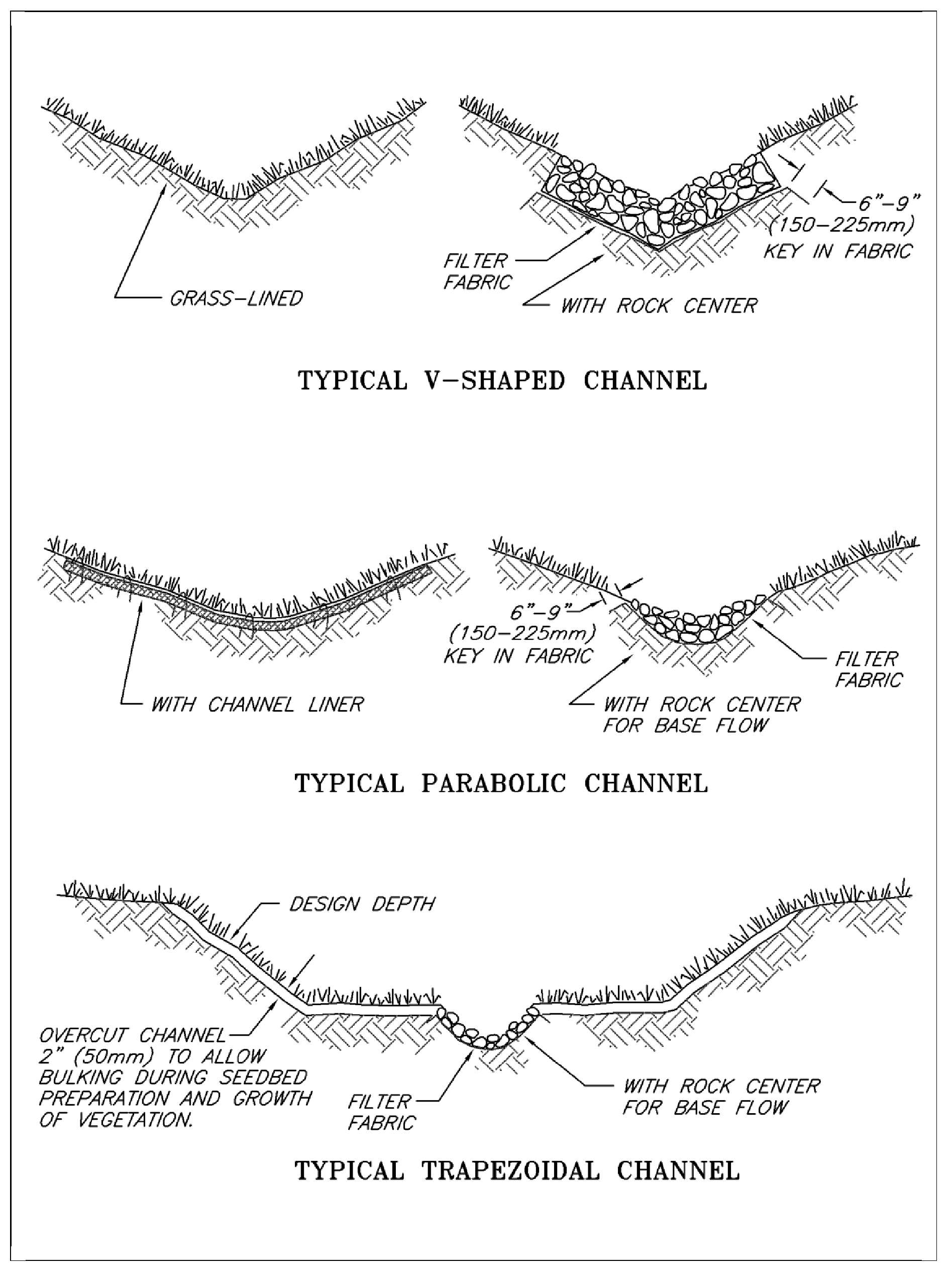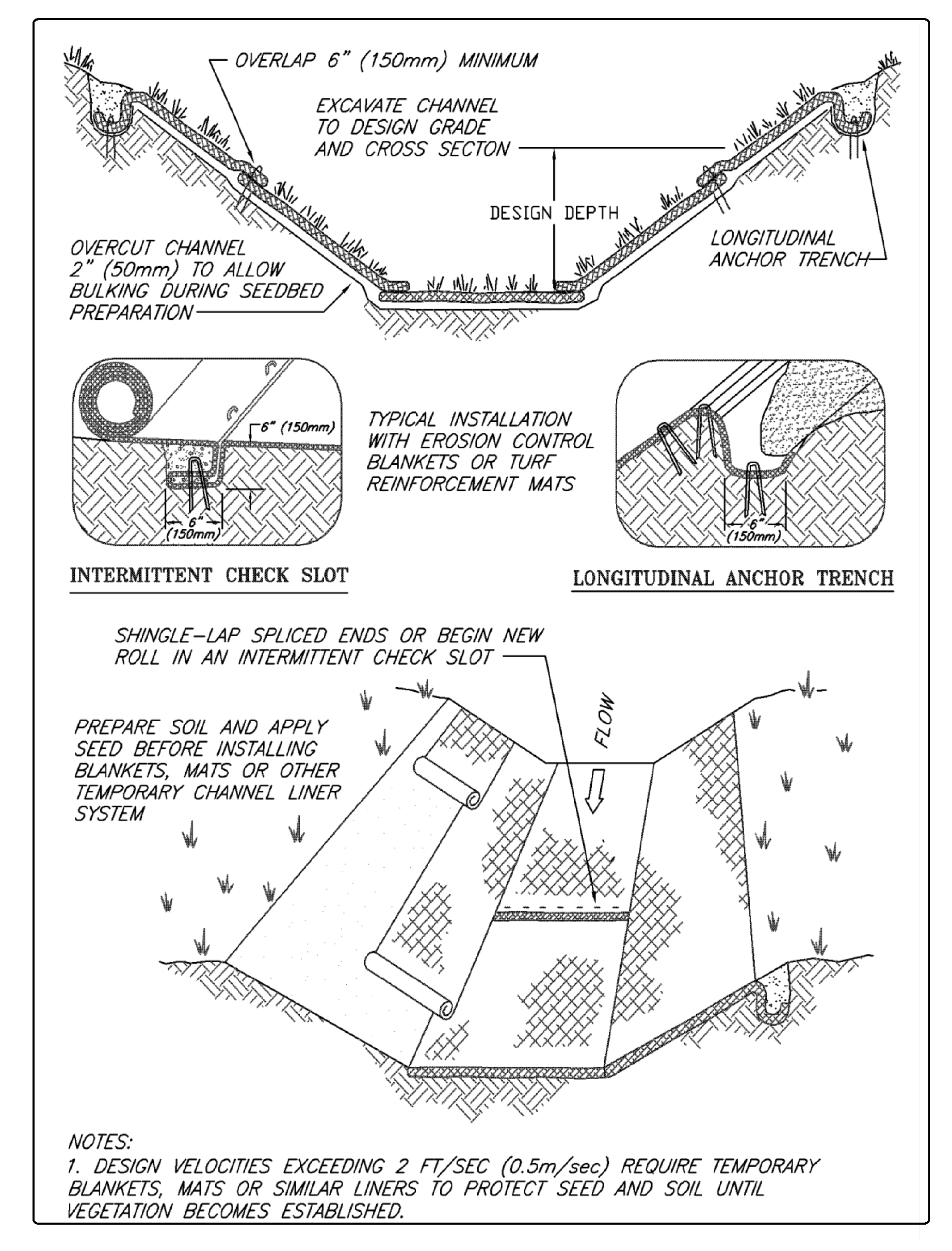1.26 BMP C201 - Grass-Lined Channels
To provide a channel with a vegetative lining for conveyance of runoff. See Figure 3 - 9: Typical Grass-Lined Channels, for typical grass-lined channels.
This practice applies to construction sites where concentrated runoff needs to be contained to prevent erosion or flooding.
Use this BMP when a vegetative lining can provide sufficient stability for the channel cross section and lower velocities of water (normally dependent on grade). This means that the channel slopes are generally less than 5 percent and space is available for a relatively large cross section.
Typical uses include roadside ditches, channels at property boundaries, outlets for diversions, and other channels and conveyance ditches in low areas.
Channels that will be vegetated should be installed before major earthwork and hydroseeded with a bonded fiber matrix (BFM). The vegetation should be well established (i.e., 75 percent cover) before water is allowed to flow in the ditch. With channels that will have high flows, erosion control blankets should be installed over the hydroseed. If vegetation cannot be established from seed before water is allowed in the ditch, sod should be installed in the bottom of the ditch in lieu of hydromulch and blankets.
1.26.3 Design and Installation Specifications
Locate the channel where it can conform to the topography and other features such as roads.
Locate them to use natural conveyance systems to the greatest extent possible.
Avoid sharp changes in alignment or bends and changes in grade.
Do not reshape the landscape to fit the conveyance channel.
Base the maximum design velocity on soil conditions, type of vegetation, and method of revegetation, but at no times shall velocity exceed 5 feet/second. Size the channel to contain the flowrate calculated by one of the following methods using the worst-case land cover:
The peak volumetric flowrate calculated using a 10-minute timestep from a Type 1A, 10-year, 24-hour storm using a single event model, or
The 10-year return period flowrate, indicated by an Ecology-approved continuous simulation model, using a 15-minute timestep.
An established grass or vegetated lining is required before the channel can be used to convey stormwater, unless stabilized with nets or blankets.
If the design velocity of a channel to be vegetated by seeding exceeds 2 ft/sec, a temporary channel liner is required. See Figure 3 - 10: Temporary Channel Liners.
Remove check dams when the grass has matured sufficiently to protect the ditch or swale unless the slope of the swale is greater than 4 percent. Seed and mulch the area beneath the check dams immediately after dam removal.
If vegetation is established by sodding, the permissible velocity for established vegetation may be used and no temporary liner is needed.
Do not subject grass-lined channel to sedimentation from disturbed areas. Use sediment-trapping BMPs upstream of the channel.
V-shaped grass channels generally apply where the quantity of water is small, such as in short reaches along roadsides. The V-shaped cross section is least desirable because it is difficult to stabilize the bottom where velocities may be high.
Trapezoidal grass channels are used where runoff volumes are large and slope is low so that velocities are nonerosive to vegetated linings.
Note: It is difficult to construct small parabolic shaped channels.
Subsurface conveyance systems (such as perforated pipe), or riprap channel bottoms, may be necessary on sites that are subject to prolonged wet conditions due to long duration flows or a high water table.
Provide outlet protection at culvert ends and at channel intersections.
Grass channels, at a minimum, should carry the peak volumetric flowrate for temporary construction stormwater facilities from the 10-year, 24-hour frequency storm assuming a Type 1A rainfall distribution (3.0-inches) using a 10-minute timestep without eroding. Where flood hazard exists, increase the capacity according to the potential damage.
Grassed channel side slopes generally are constructed 3:1 or flatter to aid in the establishment of vegetation and for maintenance.
Construct channels a minimum of 0.2 foot larger around the periphery to allow for soil bulking during seedbed preparations and sod buildup.
During the establishment period, check grass-lined channels after every rainfall.
After grass is established, periodically check the channel; check the channel after every heavy rainfall event. Immediately make repairs.
It is particularly important to check the channel outlet and all road crossings for bank stability and evidence of piping or scour holes.
Remove all significant sediment accumulations to maintain the designed carrying capacity. Keep the grass in a healthy, vigorous condition at all times, since it is the primary erosion protection for the channel.
Figure 3 - 9: Typical Grass-Lined Channels
Figure 3 - 10: Temporary Channel Liners

